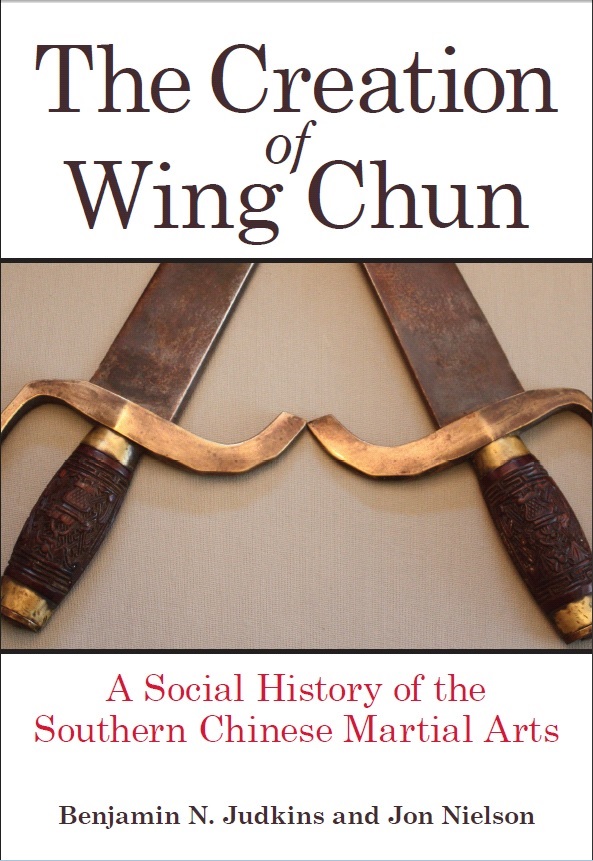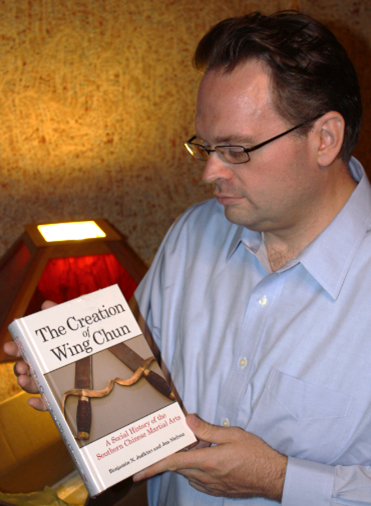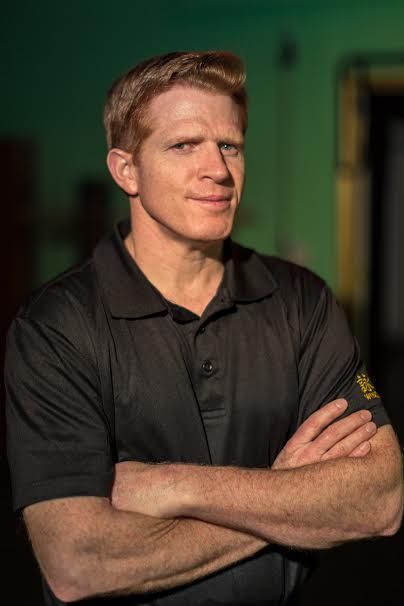 Benjamin N. Judkins holds a doctoral degree in political science from Columbia University. Jon Nielson is chief instructor at Wing Chun Hall in Salt Lake City, Utah. They have joined forces to write THE CREATION OF WING CHUN: A SOCIAL HISTORY OF THE SOUTHERN CHINESE MARTIAL ARTS, published by the esteemed scholarly press SUNY. The work covers much more than just Wing Chun. Part I: Hand Combat, Identity, and Civil Society in Guangdong, 1800–1949, is a fascinating read for any serious student of Kung Fu. It provides an inclusive timeline for Jingwu, Hung Mun, Hung Sing, Hakka, and the Central Guoshu Academy from a socioeconomic perspective that is insightful and thought-provoking. This is one of the most exciting new contributions to the field. I had the opportunity to discuss this book with the authors.
Benjamin N. Judkins holds a doctoral degree in political science from Columbia University. Jon Nielson is chief instructor at Wing Chun Hall in Salt Lake City, Utah. They have joined forces to write THE CREATION OF WING CHUN: A SOCIAL HISTORY OF THE SOUTHERN CHINESE MARTIAL ARTS, published by the esteemed scholarly press SUNY. The work covers much more than just Wing Chun. Part I: Hand Combat, Identity, and Civil Society in Guangdong, 1800–1949, is a fascinating read for any serious student of Kung Fu. It provides an inclusive timeline for Jingwu, Hung Mun, Hung Sing, Hakka, and the Central Guoshu Academy from a socioeconomic perspective that is insightful and thought-provoking. This is one of the most exciting new contributions to the field. I had the opportunity to discuss this book with the authors.
GC: You are both Wing Chun practitioners obviously. Tell us a little about your background with this style and why you came to practice it.
BJ: While I had some interest in the martial arts, I had never really considered studying a Chinese style before moving to Salt Lake City about ten years ago. While working at the University of Utah my wife decided that she wanted to take a self-defense class. I did a little bit of research on what was available in the area and it looked like Wing Chun might be a good fit, and I agreed to sign up for a class with her. That is how I first met Sifu Jon Nielson.
While we both enjoyed the class, I was struck with how differently Wing Chun approached basic questions of movement from the Japanese and Korean arts I was more familiar with. I felt compelled to dig deeper to try to understand what was going on at both a physical and historical level.
JN: I had practiced several styles of martial arts before I stumbled on Wing Chun. All of the others left me with questions as to how and when to apply the different techniques and how they all fit together. Wing Chun immediately started answering those questions for me, and it has continued to be a source of investigation and discovery from that time until now.
GC: Ben, your blog, Kung Fu Tea, has been going since 2012. For those of our readers who aren’t familiar with Kung Fu Tea, explain what your intentions for this are. What inspired you to launch this? Has it met with your expectations so far?

Ben Judkins
BJ: There were a few different reasons why I started that blog. By the summer of 2012 most of the basic writing and research on our book was already done and I was getting ready to start shopping the manuscript to university presses. That can be a long process even under the best of circumstances (academic publisherS tend to move slowly compared to commercial ones), and since our volume was attempting to further a relatively new research area, I expected that there might be some delays.
Starting a blog seemed like a great way to use some of the down-time during the review process. It has allowed me to systematically explore other areas of the Chinese martial arts that I might not have otherwise engaged with. Finally, Kung Fu Tea has been really helpful in pulling together a community of individuals who shared our passion for a more academic approach to the martial arts. Anyone who is interested in checking out the blog can find it at chinesemartialstudies.com.
Kung Fu Tea has far exceeded my initial expectations. The last few years have seen an increase of interest in the martial arts by both scholars and graduate students in a variety of fields. And it turns out that a surprising number of martial arts practitioners are also interested in seeing the growth of a more rigorous discussion of the history, sociology and cultural meaning of these fighting systems. In fact, while attending the recent Martial Arts Studies conference at the University of Cardiff, I had an opportunity to meet readers from all over the world who were coming together to present and discuss their own research. It was an incredibly exciting moment. I think that opening a door to these sorts of conversations is about the best thing that an academic blog can do.
GC: What inspired you to write THE CREATION OF WING CHUN?
JN: When I met Ben in 2005, I had been studying and practicing Wing Chun for 25 years, but I had yet to see anyone do a serious treatment of Wing Chun’s origins. Back then, very few people took martial studies seriously as an academic pursuit. Any attempt at ferreting out Wing Chun’s origins was done through oral stories that isolated themselves from any real history.
I was interested in what else was going on socially, politically, economically and religiously. I thought that if we could get a better idea of how those movements corresponded with the developing martial arts, we might have a better idea of the events that shaped what eventually became known as Wing Chun.
When Ben told me that he was a political scientist with an interest in anthropology, I asked him if he was interested in researching this topic. Ten years later, they’re finally publishing our book.

Sifu Jon Nielson
BJ: Sifu Nielson was really the driving force behind the genesis on this project. After studying with him for a while he told me about his desire to create a book that would explain the origin and nature of Wing Chun in a historical way, rather than one that simply replicated the oral folklore that surrounds the Chinese martial arts. At the same time that he approached me with this idea, I had been working on a conference paper looking at a few different aspects of the Boxer Uprising which erupted at the turn of the 20th century in northern China.
I realized that beyond simply telling the story of Wing Chun, the evolution and development of the Chinese martial arts provided a really important window onto the sorts of social conflict and disruptions that accompanied the advance of imperialism, trade and globalization in China during the 19th century. In many ways these forces shaped the development of what we now think of as the traditional martial arts. Nowhere was that more apparent than in southern China. So this book really grew out of the realization that the answer to the specific question of how Wing Chun evolved had broader implications for all sorts of questions about globalization, identity formation and social conflict in late 19th and early 20th century China.
GC: Tell me a little bit about the title of your book? What does it convey and what sort of audience are you trying to reach?
BJ: Our title went through a couple of iterations. My original idea was “Rebels on Red Boats: A Social History of the Southern Chinese Martial Arts.” I loved that it captured the romanticism of the Cantonese Opera Rebellion (otherwise known as the Red Turban Revolt) and the ways in which its memory has echoed through the history of the martial arts in that area. It also emphasized the fact that this book really addresses the milieu that all of the southern Chinese martial arts emerged from. So if you are a Choy Li Fut or Hung Gar practitioner, you may find something in here that is interesting. All of these arts emerged from the same general area and historical processes. That was one of the things that we were ultimately trying to get at.
However, our publisher thought a more specific and tightly focused title that emphasized Wing Chun might be better. And that is certainly true. In the second half of the book we outline Wing Chun’s rise both as a regional and later as a global art. Still, you cannot really divorce that narrative from everything else that was going on around it, both socially, politically, and in the world of the martial arts. And I still think that “Rebels on Red Boats” has a nice ring to it. Maybe we will save it for a future project.
GC: I was really impressed by Part 1 of your book. It’s one of most cohesive histories of the development of southern Kung Fu since the fall of the Qing I’ve read so far. What were some of the unique approaches and challenges you encountered when tackling this?
BJ: I think that the main thing was just that this is a relatively new exercise in what is still a theoretically developing research area. Douglas Wile really demonstrated the possibility for this sort of project with his 1996 volume, The Lost T’ai-chi Classics from the Late Ch’ing Dynasty (also published by the State University of New York Press). Meir Shahar’s volume on Shaolin and Peter Lorge’s wider historical work helped us to build a case that there is both an academic and popular audience for this sort of work beyond what you might expect.
Still, there had not yet been a really focused (English language) academic study of the southern Chinese martial arts. We were left to search through the existing literature in order to pull together a compelling vision of what was going on in the region that could account both for the broad outlines of the development of southern Kung Fu, but also suggest some new and interesting areas for investigation that might not have been as obvious at the outset. And since we were also free to define the theoretical scope of this project, we wanted to do something that would demonstrate the inherent strength of an interdisciplinary approach in tackling questions like these.
One of the things which surprised us both was that once we got into it, we found that there was already a fair amount of information in the historical and social scientific literature on the region. More than one might expect at any rate. Yet previous scholars had not been looking specifically at the martial arts and there was very little sense of what was relevant or how these discrete things fit together.
JN: Mainly what got in the way was what had been done on the Wing Chun creation myth previous to our efforts. You find that people have a strong tendency to cling to old notions, even when evidence to the contrary is right in front of them. We had to sort through and discard a lot of poor scholarship to get to the bottom of what was really going on. What we found, though, was that much of what we had been looking for was already published in scholarly books and articles. It’s just that no one had put it all together before.
GC: What aspects of Chinese history do you find are the most misunderstood amongst Chinese martial arts aficionados?
BJ: The traditional martial arts are a topic that many people feel very passionately about, and yet there is a lot of room for misunderstanding. Mostly we get the setting all wrong. One of the main difficulties in explaining the deeper history of these arts is that most people have very little idea what traditional Chinese society itself looked like. This is not necessarily an easy thing to reconstruct and there are many historians who have dedicated their entire careers to those questions.
What we found when looking at events in the Pearl River Delta region was that the martial arts did not really exist as a set of separate or independent institutions apart from the rest of society. These organizations tended to be supported by, and deeply implicated in the competition between, powerful lineage clans, economic guilds (and later trade unions), secret societies, the government, social movements and political factions. Changes in this broader social environment were often the precondition for big shifts in how the martial arts were organized.
A really exciting thing about Chinese martial studies as an academic research area is that it opens a very detailed window onto the interactions of these diverse actors. Yet most often the histories of the martial arts are discussed without this sort of social context. In that case, even if all of the facts that you have learned are true, they are not likely to be all that meaningful.
I think that many readers initially approach the Chinese martial arts as something impossibly ancient that emerged only in sacred temples on some misty mountain. In that sense they have become a typical Orientalist fantasy for Western consumers. Most of the hand combat teachers critical to our current styles lived in the 19th and 20th centuries. That means that when we think about the “traditional” martial arts, we are dealing with a pretty modern body of practices and meanings. As Douglas Wile has reminded us:
“Anything earlier than the Republican period (1911–1949) tends to slip into the mists of “ancient China,” and we often overlook the fact that Yang Lu-ch’an and the Wu brothers were of the same generation as Darwin and Marx, and that the Li brothers were contemporaries of Einstein, Freud and Gandhi. Railroads, telegraphs, and missionary schools were already part of the Chinese landscape, and Chinese armies (and rebels) sometimes carried modern Western rifles…It is our proposition, then, that this watershed period in the evolution and theory of t’ai-chi chüan did not take place in spite of larger social and historical events but somehow in response to them.” (Wile, 3)
Wile’s remarks on this point are important and bear repeating. In some ways the popular discussion of Chinese martial arts have progressed a lot since he wrote those words in 1996, and yet there is still this disturbing sense that somehow these fighting systems are primeval, existing outside of the push and pull of ordinary historical or social forces. One of the goals of our work has been to provide a framework that will strongly ground discussions of Wing Chun, and the other Southern martial arts, within the flow of actual social, economic and political history.
For Part 2, click here.
About
Gene Ching :
![]() For more information on THE CREATION OF WING CHUN: A SOCIAL HISTORY OF THE SOUTHERN CHINESE MARTIAL ARTS by Benjamin N. Judkins and Jon Nielson, visit SunyPress.edu.
For more information on THE CREATION OF WING CHUN: A SOCIAL HISTORY OF THE SOUTHERN CHINESE MARTIAL ARTS by Benjamin N. Judkins and Jon Nielson, visit SunyPress.edu.
![]() Print Friendly Version of This Article
Print Friendly Version of This Article
















